| ELECTROHYPE 2010 – KONSTNÄRER |
|
ELECTROHYPE 2010 – ARTISTS |
| |
|
|
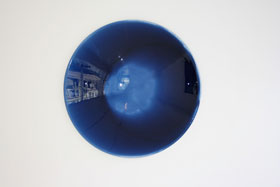 |
 |
| |
|
Serina Erfjord, Norge |
Serina Erfjord, Norway |
Normal. Blue (2010) ser ut som en stor blå cirkel på väggen. I själva verket är det en parabolantenn inbyggd i väggen och fylld med flera lager trögflytande blå oljefärg. Endast den långsamt och ständigt roterande rörelsen motverkar gravitationen och hindrar färgen från att släppa kanterna och rinna ner ut över golvet. |
Normal. Blue (2010) looks like a huge blue circle on the wall. As a matter of fact it is a satellite dish, built in to the wall and filled with oil paint. Only the very slow and constant rotation of the disc counteracts gravity and prevents the viscous oil from running over the edge and staining the floor beneath. |
| |
|
| |
|
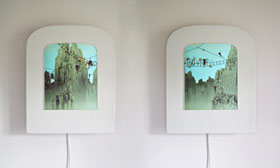 |
 |
| |
|
boredomresearch, Storbritannien |
boredomresearch, United Kingdom
|
Lost Calls of Cloud Mountain Whirligigs (2010) är en virtuell värld befolkad av så kallade Whirligigs, en rad mystiska flygande livsformer med en livslängd på några dagar. Varje gång en Whirligigs dör ersätts den av en ny slumpmässigt genererad individ, vilket medför att nya skiftande livsformer och mönster ständigt uppstår och utvecklas. Betraktaren för stunden får endast se en liten del av den oändliga mångfald som verket i sin helhet alstrar. |
Lost Calls of Cloud Mountain Whirligigs (2010) is a world populated with so-called Whirligigs; mysterious flying life forms with a lifespan of a couple of days. As old Whirligigs are lost, new ones are created, and so life goes on in this imaginary world. Each new Whirligig is generated randomly allowing the diversity of form and pattern to be explored over an extended time period. The viewer of the moment only gets to see just one slice from the immense diversity this work explores over time. |
| |
|
| |
|
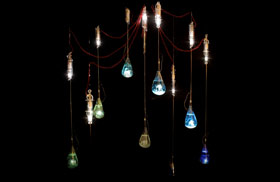 |
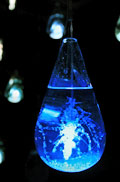 |
| |
|
Sion Jeong, Korea |
Sion Jeong, Korea |
Karat (2010) är en sfäriskt formad ljud- och ljusinstallation som består av nio glasdroppar. I varje droppe växer det kristaller. Kristallerna blir som växande organismer inuti sfären. Det hela kan ses som en suggestiv och poetisk bild av livet i sig, vars förnyelse alltid uppstår via förlust i en ständigt pågående förvandling. |
Karat (2010) is an audio and light installation consisting of nine teardrop-shaped glass containers. In each container crystals are growing. The crystals constitute an organism that is created and realized within this sphere and can be seen like a suggestive and poetic metaphor for life itself, whose renewal always goes through loss in its own perpetual transformation. |
| |
|
| |
|
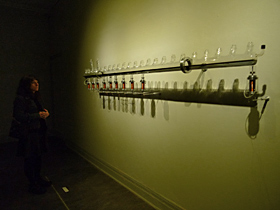 |
 |
| |
|
Yunchul Kim, Korea |
Yunchul Kim, Korea |
Epiphora (2009) är ett slags tvådelat virtuellt organ med diagnosen Epiphora eller “abnormt tårflöde”. Båda organen är försedda med elektromagnetiska spolar som får vätskan i rören att pulsera. De tycks dessutom stå i förbindelse med varandra, få varandra att reagera på olika sätt. Den som studerar verket ser ett fenomen och ett sekundärt fenomen, ett så kallat epifenomen, som åtminstone förefaller vara reellt. I själva verket har konstnären, inspirerad av den virtuella så kallade patafysiken, skapat ett föremål som subjektivt inte längre tjänar sin egen materialitet. |
Epiphora (2009) is an imaginary organ divided in two, which shows Epiphora “abnormal overflow” as its symptom. Coils below each part of the organ generate an electromagnetic field, which triggers movements in the black fluid, but the two organs also seem to communicate. The observer studying the work sees the phenomena and the epiphenomena of something that at least appear to be a physical reality. In fact the artist, inspired by the virtual so called pataphysics, has created a material, which no longer serve its own solid form, but produces as an evocative subject its materiality. |
| |
|
| |
|
 |
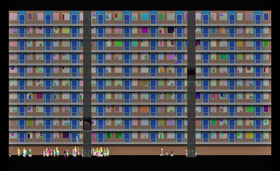 |
| |
|
Nikki Koole, Nederländerna |
Nikki Koole, The Netherlands |
Procedural Flat v 2.0 (2010) förefaller vara en klassisk myrfarm där man genom två glasskivor kan studera insekter av olika slag, men visar sig vara en mänsklig koloni; ett flervåningshus med ± 250 successivt genererade inneboende. Är det oss själva vi ser? Allt från människornas utseende och beteenden till inredningen i deras lägenheter är genererat med datoralgoritmer. Den mindre skalan gäller inte bara huset och dess inneboende, utan också tiden. En dag i denna virtuella värld varar endast i tio minuter. |
Procedural Flat v 2.0 (2002) At the first glance the work looks like a classic ant farm where you can study life and activities through transparent walls, but when you get closer you will see that there are tiny people living behind the shielding glass. This human colony is represented as a housing block with ± 250 procedurally generated inhabitants. Is it ourselves we are watching? Everything is generated with computer algorithms, from people’s appearance and their agenda, to the decoration in their apartment. Not only the building and the people living in it are scaled down, time has also been adapted to a smaller scale. One day in this world only takes ten minutes. |
| |
|
| |
|
 |
 |
| |
|
Diane Landry, Kanada |
Diane Landry, Canada |
Mandalas in series Blue Decline (2002) Mandala är sanskrit och betyder cirkel. I den österländska traditionen är mandalan en symbol för universum och används för kontemplation/meditation. Konstnären kallar sina verk för oeuvre mouvelle. Vill man uppleva dem till fullo bör man betrakta dem under en längre tid. Här använder hon sig av tomma mineralvattenflaskor (av den typ som numera finns över hela världen) för att bygga upp sina egna skuggversioner av mandalan. Titlarna har de fått efter varumärket på vattnet flaskorna en gång innehöll, t.ex. ”Mandala Labrador”, ”Mandala Perrier” och ”Mandala Naya”. |
Mandalas in series Blue Decline (2002) The word Mandala derives from the Sanskrit word for circle. A mandala is an artistic representation of the cosmos, and is used in eastern religious traditions as a focus for contemplation/ meditation. The artist calls her artworks oeuvre mouvelle, and they must be watched for some time before their full meaning is grasped. Here she uses the now ubiquitous plastic water bottles, as the basic building block in her shadow versions of this spiritual symbol. Each of Landry’s mandalas is created from one or two kinds of bottles, and bears the name of the brand of water it once held: “Mandala Labrador”, “Mandala Perrier” and “Mandala Naya”. |
| |
|
| |
|
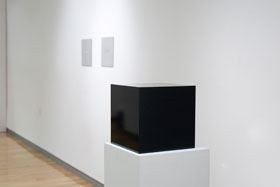 |
 |
| |
|
Caleb Larsen, USA |
Caleb Larsen, USA |
A Tool to Deceive and Slaughter (2009) innehåller en mikrodator och en internetuppkoppling. Var tionde minut kopplar konstverket automatiskt upp sig på nätet och kontrollerar att det finns med i någon pågående auktion på eBay. Om så inte är fallet, ser det genast till att skapa en ny auktion. Verket är inte bara ständigt till salu, det är genom den funktionen som det dessutom får sin legitimitet. Allt stipuleras i ett kontrakt som köparen måste skriva under, där han eller hon binder sig att koppla upp verket till internet och omgående packa ned och frakta iväg det om det köps av någon annan, som i sin tur binder sig att koppla upp verket till internet o.s.v. |
A Tool to Deceive and Slaughter (2009) is an eight-inch high gloss black cube containing a micro controller and an Ethernet adapter. Every ten minutes, it connects to the internet to check if the artwork itself has an active auction on eBay. If an auction does not exist, then it creates one for itself. As a result, the piece is constantly for sale. In the event the piece is purchased, the contract (included in the auction listing) stipulates that the work is to be packaged and transferred to the new owner, who then, also according to the contract, must connect it to the Internet. The sculpture automatically places itself for sale again and the cycle repeats. |
| Följ aktuell auktion här. |
Follow the current auction here. |
| |
|
| |
|
 |
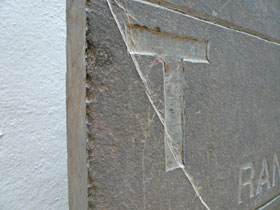 |
| |
|
| Enrique Radigales, Spanien |
Enrique Radigales, Spain |
Frieze (2009) består av sex block av så kallad svart Calatorao marmor, en särskild sten från det spanska distriktet Valdejalón. Tangenterna “S”, “P”, “E”, “C”, “T”, “R”, “U” och “M” har för hand ristats in i stenarna av en stenhuggare och liknar tangenterna på en Spectrum ZX hemdator från tidigt 80-tal. Verket påminner om en fris från den grekiska antiken och kan ses som ett slags nutida ruin med förmågan att återge vår egen tids teknologi ur ett perspektiv vi människor sällan tänker på. |
Frieze (2009) is divided into six black blocks of so-called Calatorao marble, a special limestone from the Valdejalón district of Spain. On these blocks the keys “S”, “P”, “E”, “C”, “T”, “R”, “U” and “M” have been manually carved and sculpted following the genuine design of the early 1980’s Spectrum ZX personal computer. The piece is reminiscent of an old frieze from the classical Greek period; a sort of contemporary ruin showing the ephemeral character of recent technology from a perspective we, as human beings, not always think of. |
| |
|
| |
|
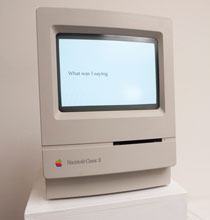 |
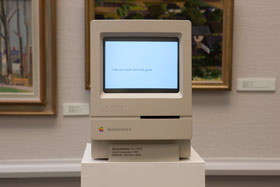 |
| |
|
David Rokeby, Kanada |
David Rokeby, Canada |
Liquid Language (1989) är ett så kallat Hypercard-program som konstnären gjorde i samband med en samlingsutställning om bokens framtid. Verket består av ett stort antal meningsfragment. Dessa kopplas genom en avvägd slumpmässig algoritm till en av tre fraser som handlar om att minnas, glömma eller drömma. Orden har konstnären hämtat från samtal med en god vän som då nyligen förlorat en närstående. |
Liquid Language (1989) is a so called Hypercard stack created for an exhibition with works exploring the future of the book. The piece is made up of a large number of text fragments linked through a branching mechanism. Each text is linked to three other texts: one that moves towards ideas of remembering, another that tends toward forgetting, and a third that tends toward dreaming. The content of the work derive from talks the artist had around that time with a close friend who had recently experienced a tragic loss. |
| |
|
| |
|
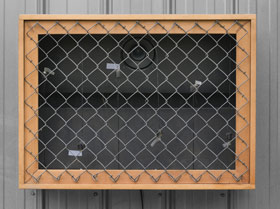 |
 |
| |
|
Norman T White, Kanada |
Norman T White, Canada
|
The Music Lesson (1984) började som en bandinspelning på en lågstadieskola, där konstnären på den tiden arbetade som hjälplärare. En dag råkade han ha en bandspelare med sig och blev så fascinerad av den musiklektion som följde att han var tvungen att spela in den. Föreställ dig en rad sjuåringar som gör fingerövningar på papperskopior av pianotangenter, medan två av dem är tvungna att utföra samma övningar på ett riktigt piano. Scenen fick konstnären att associera till nattfjärilar som förgäves försöker fly genom en skol- eller fängelsevägg. |
The Music Lesson (1984) began as a tape segment recorded at a grade school while the artist was volunteering as an after-hours teacher. He happened to have a tape recorder with him, and the music lesson that followed his class was so astounding that he felt obliged to record the sound from it. Picture a bunch of 7 year-olds performing finger exercises on paper replicas of piano keyboards while two at a time are required to perform the same exercise on an actual piano. The classroom scene reminded the artist of moths beating their wings against the confines of a school/prison. |
| |
|
| |
|
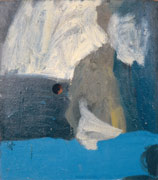 |
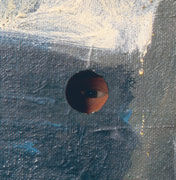 |
| |
|
| Norman T White, Kanada |
Norman T White, Canada |
Bellevue (2001) råkar vara en av de få oljemålningar som konstnären är riktigt nöjd med. Men om verket är bra eller dåligt är inte relevant i det här sammanhanget. Tavlan uppnår sitt syfte i det ögonblick då besökarna flyktigt betraktar den (på det sätt som konstpublik ofta gör) och plötsligt inser att de i sin tur, då och då genom ett hål i tavlan, betraktas av någon annan. |
Bellevue (2001) is at a superficial glance just a painting. It also happens to be one of the few paintings the artist is pleased with. However, its “goodness” is irrelevant. The true purpose of this painting is realized when it is being viewed in a careless, cursory way – the way many people making the rounds of an exhibition do – and the visitors suddenly are caught off-guard by the opening of the surveillance hole where they see someone watching them. |
| |
|
| |
|